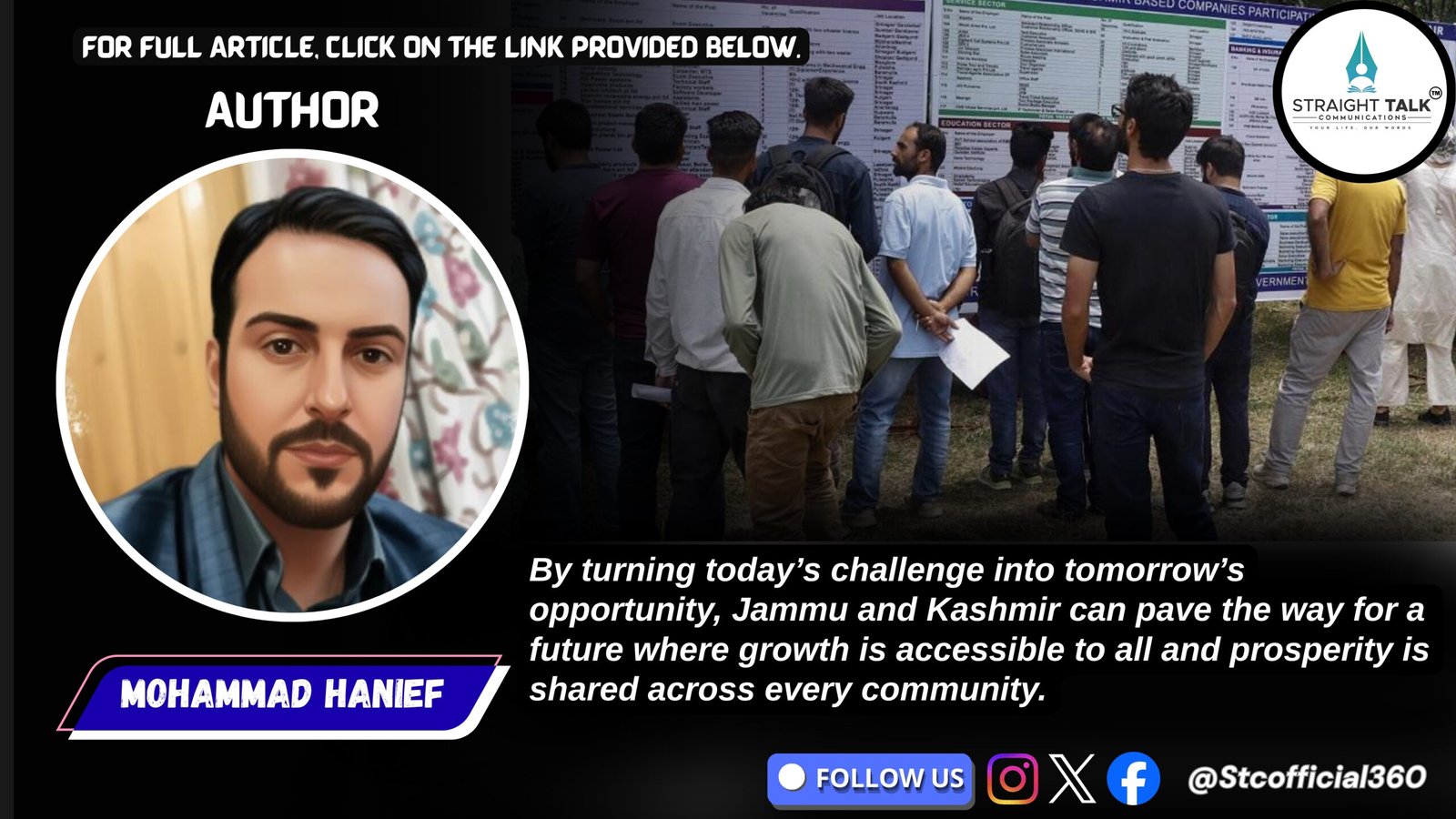Unemployment in J&K: From Joblessness to Opportunity

By turning today’s challenge into tomorrow’s opportunity, Jammu and Kashmir can pave the way for a future where growth is accessible to all and prosperity is shared across every community.
Mohammad Hanief
Unemployment continues to remain one of the most persistent socio-economic challenges in Jammu and Kashmir. Despite multiple government initiatives, joblessness, particularly among the youth and women, still weighs heavily on the region’s developmental aspirations. While there has been some improvement in recent years, the situation demands urgent attention, deeper reforms, and a sustained focus on creating a robust and inclusive employment ecosystem.
The overall unemployment rate in J&K is 6.7%, nearly double the national average of 3.5%, according to the Baseline Survey Report 2024-25 under Mission YUVA (Yuva Udyami Vikas Abhiyan), which cited the Periodic Labour Force Survey (PLFS) 2023-24.
Among young people, the problem is more acute. The report states that “The youth unemployment rate is even more concerning at 17.4%, compared to India’s 10.2%, indicating a serious gap in traditional employment opportunities. This reflects both the seriousness of the challenge and the growing dependence on the state for solutions.
The gender gap in unemployment is particularly stark. Women face even steeper barriers, with urban female unemployment recorded at 28.6%, underscoring the urgent need for inclusive economic interventions.
Women, especially in rural and semi-urban areas, face disproportionately higher barriers to securing meaningful work. In the younger age group, urban female unemployment has remained alarmingly high, far exceeding the national average. Rural women too experience limited opportunities, often restricted to low-paying or informal forms of work. Social norms, limited access to transport, and inadequate participation in skill development programmes compound their exclusion, leaving large segments of women economically underrepresented and dependent.
Several structural obstacles underpin the unemployment problem. The private sector in Jammu and Kashmir remains underdeveloped compared to other parts of the country. Persistent security concerns, poor infrastructure, unreliable electricity supply, and difficulties in accessing credit discourage entrepreneurial activity and outside investment. Entrepreneurs frequently encounter complex bureaucratic procedures and logistical constraints that slow down or even prevent the growth of businesses capable of generating sustainable employment.
The education system further complicates matters. Each year, thousands of graduates enter the labour market, yet many find themselves unprepared for available opportunities. The emphasis remains heavily on theoretical knowledge, with insufficient focus on practical and vocational training. As a result, even educated young people often lack the skills required by modern industries, creating a mismatch between qualifications and employability.
To address these gaps, successive governments in Jammu and Kashmir have rolled out a variety of interventions. Self-employment schemes such as Mumkin and Tejaswini have sought to empower youth and women through financial support for entrepreneurial ventures. Since 2021, such initiatives have facilitated the creation of over nine lakh employment opportunities. Recruitment in the public sector has also been a source of stability, with thousands of appointments made across government departments in recent years. Rural households have benefitted from schemes such as MGNREGA, which has generated millions of person-days of employment, providing temporary relief in economically weaker communities. More recently, ambitious projects like Mission Yuva have been announced with the aim of establishing entrepreneurial units and generating substantial employment for the youth population.
Yet, despite these steps, the challenge remains significant. Short-term relief programmes and isolated interventions cannot alone resolve what is essentially a structural issue. For meaningful progress, Jammu and Kashmir must cultivate an ecosystem where education, skills, infrastructure, and investment work in tandem to create sustainable employment opportunities.
One of the foremost needs is a thorough reform of the education and training system. Greater emphasis must be placed on vocational learning, digital literacy, and market-driven skills. Linking academic institutions with industries through structured collaborations would ensure that graduates are prepared for real-world challenges rather than being confined to theoretical knowledge.
Equally important is the expansion of private sector activity. For decades, employment in the region has been disproportionately dependent on government jobs, but this model is neither scalable nor sustainable. A business-friendly environment, supported by streamlined regulations, reliable infrastructure, and financial incentives, can encourage investment and entrepreneurship. Tourism, horticulture, handicrafts, IT services, and renewable energy are some of the sectors with immense untapped potential. Harnessing these industries can provide diverse and large-scale employment opportunities.
Addressing gender disparities must also be central to any employment strategy. Women’s economic participation can be significantly enhanced through policies that ensure workplace safety, flexible work models, targeted financial assistance, and mentorship programmes. Efforts to break cultural barriers and expand mobility through better infrastructure would enable women to access the labour market more freely and productively.
In addition, the digital economy offers promising opportunities for a region like Jammu and Kashmir, where physical and geographical constraints have historically limited industrial growth. Online education, freelancing, IT-enabled services, and e-commerce can help youth connect to global markets from within their homes. By investing in digital literacy, co-working spaces, and online job platforms, the government and private sector can open entirely new avenues of employment.
Infrastructure remains another crucial area. Without reliable transport, electricity, and communication networks, efforts to expand industries or connect youth to opportunities are bound to falter. Investment in road networks, power grids, and digital connectivity is not only essential for industrial growth but also for making daily commuting and business operations more feasible.
Ultimately, unemployment in Jammu and Kashmir is not simply about a lack of jobs. It is about an underutilized workforce, an education system in need of reform, an underdeveloped private sector, and deep-rooted socio-economic barriers, particularly for women. The problem cannot be solved through isolated schemes or temporary measures. What is needed is a holistic vision that integrates education, industry, governance, and society into a single framework for growth.
The government has taken commendable steps, but these must be supported by consistent implementation, transparency, and community participation. Youth must be encouraged not only to seek jobs but to create them, and women must be fully included in this process. Public-private partnerships, stronger infrastructure, and digital innovation can together transform the region’s employment landscape.
If approached with seriousness and vision, unemployment in Jammu and Kashmir can shift from being a chronic burden to an opportunity for renewal. The region has the human capital, natural resources, and cultural strengths to build a dynamic economy that is both inclusive and resilient. Employment, after all, is not merely a matter of economic statistics—it is the foundation of dignity, stability, and shared progress. By turning today’s challenge into tomorrow’s opportunity, Jammu and Kashmir can pave the way for a future where growth is accessible to all and prosperity is shared across every community.
(The views are of the author and not that of Straight Talk Communications)







